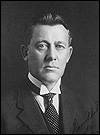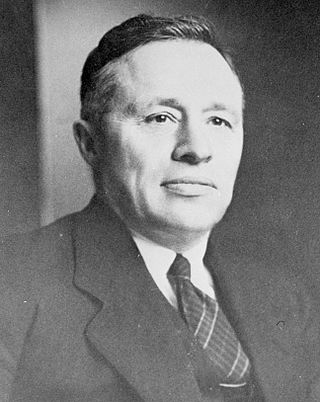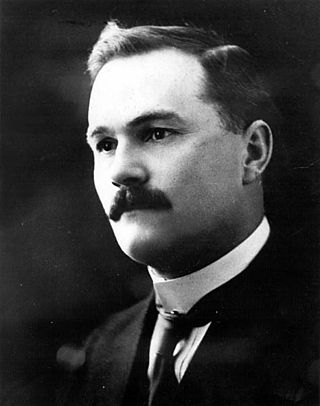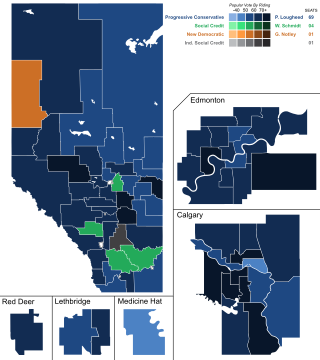Related Research Articles

The 2004 Canadian federal election was held on June 28, 2004, to elect members to the House of Commons of Canada of the 38th Parliament of Canada. The Liberal government of Prime Minister Paul Martin lost its majority but was able to continue in office as a minority government after the election. This was the first election contested by the newly amalgamated Conservative Party of Canada, after it was formed by the two right-of-centre parties, the Progressive Conservative Party and the Canadian Alliance.

John Bracken was a Canadian agronomist and politician who was the 11th and longest-serving premier of Manitoba (1922–1943) and later the leader of the Progressive Conservative Party of Canada (1942–1948).
The Progressive Conservative Party of Saskatchewan is a conservative political party in the Canadian province of Saskatchewan. Founded in 1905 by former Northwest Territories Premier Frederick Haultain, the party was first known as the Provincial Rights Party. In 1912, its name changed to the Conservative Party of Saskatchewan, and in 1942 it adopted its current name. Members are commonly known as Tories.

James Thomas Milton Anderson was the fifth premier of Saskatchewan and the first Conservative to hold the office.

James Garfield Gardiner was a Canadian farmer, educator, and politician. He served as the fourth premier of Saskatchewan, and as a minister in the Canadian Cabinet.

Charles Avery Dunning was the third premier of Saskatchewan. Born in England, he emigrated to Canada at the age of 16. By the age of 36, he was premier. He had a successful career as a farmer, businessman, and politician, both provincially and federally.

William Melville Martin served as the second premier of Saskatchewan from 1916 to 1922. In 1916, although not a member of the Legislative Assembly of Saskatchewan, Martin was elected leader of the Saskatchewan Liberal Party, succeeding Premier Walter Scott and thus became Premier of Saskatchewan.

In the Legislative Assembly of Ontario, the leader of the Official Opposition is the leader of the largest political party not in government and typically the second-largest party. The position is referred more formally as the leader of His Majesty's Loyal Opposition ; under the Westminster system, while the parliamentary opposition opposes the incumbent government, it remains loyal to the Crown and thus to Canada.
William Martin Sveinson was a Canadian professional poker player and politician. Sveinson served as a Member of the Legislative Assembly (MLA) in Saskatchewan. He was first elected under the Conservatives in 1982 and represented the riding of Regina North West.

The 1944 Saskatchewan general election, the tenth in the history of the province, was held on June 15, 1944 to elect members of the Legislative Assembly of Saskatchewan. The Co-operative Commonwealth Federation, under the leadership of Tommy Douglas, was elected to a majority government.

The 1964 Saskatchewan general election was held on April 22, 1964, to elect members of the Legislative Assembly of Saskatchewan.

The 1978 Saskatchewan general election was held on October 18, 1978, to elect members of the Legislative Assembly of Saskatchewan.

The 1975 Alberta general election was held on March 26, 1975, to elect members of the Legislative Assembly of Alberta to the 18th Alberta Legislature. The election was called on February 14, 1975 prorogued and dissolved of the 17th Alberta Legislature.
The 1934 Ontario general election was the 19th general election held in the Province of Ontario, Canada. It was held on June 19, 1934, to elect the 19th Legislative Assembly of Ontario ("MLAs").

The leader of the Official Opposition, formally known as the leader of His Majesty's Loyal Opposition, is the member of the Legislative Assembly (MLA) who leads the Official Opposition, typically the second largest party in the provincial legislature.
The Politics of Saskatchewan relate to the Canadian federal political system, along with the other Canadian provinces. Saskatchewan has a lieutenant-governor, who is the representative of the Crown in right of Saskatchewan; a premier—currently Scott Moe—leading the cabinet; and a legislative assembly. As of the most recent provincial election in 2024, the province is divided into 61 electoral districts, each of which elects a representative to the legislature, who becomes their member, or MLA. In 2024, Moe's Saskatchewan Party was elected to a majority government. Regina is the provincial capital.

Harris Turner was a Canadian journalist, soldier, publisher, and politician in Saskatchewan. In 1915, he joined the Canadian military and went overseas with the Canadian Expeditionary Force. He fought in the battle at Sanctuary Wood in 1916, where he was wounded, losing his sight.
The 6th Legislative Assembly of Saskatchewan was elected in the Saskatchewan general election held in June 1925. The assembly sat from December 3, 1925, to May 11, 1929. The Liberal Party led by Charles Avery Dunning formed the government. After Dunning entered federal politics in 1926, James Garfield Gardiner became Liberal party leader and Premier. Charles Tran, the leader of the Progressive Party, and James Thomas Milton Anderson, the leader of the Conservative Party, shared the role of opposition leader in the assembly.
The 18th Legislative Assembly of Saskatchewan was elected in the Saskatchewan general election held in June 1975. The assembly sat from November 12, 1975, to September 19, 1978. The New Democratic Party (NDP) led by Allan Blakeney formed the government. The Liberal Party led by David Steuart formed the official opposition. Edward Malone replaced Steuart as party leader in 1976. After the Progressive Conservative Party won two by-elections and convinced two Liberal members to defect in 1977, the Progressive Conservative Party led by Richard Lee Collver shared the role of official opposition with the Liberals.
